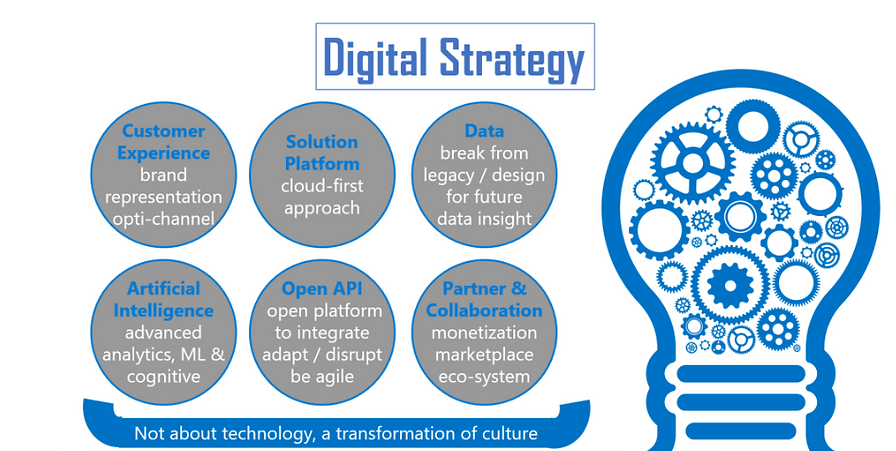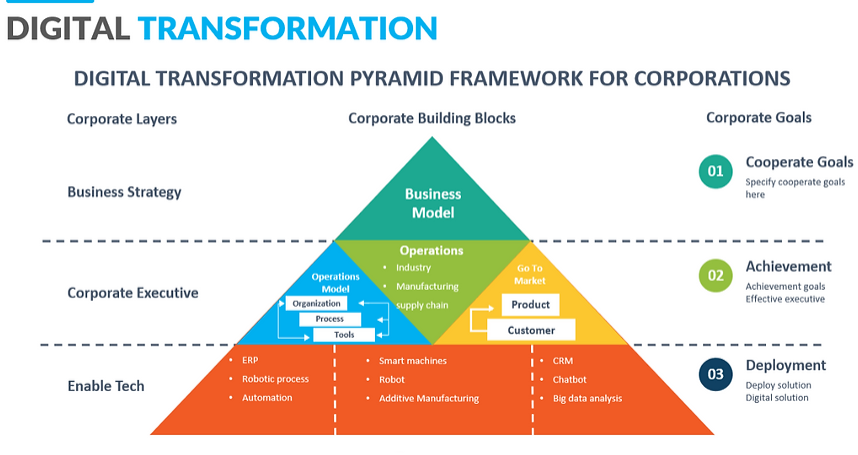Digital Transformation
- Anand Nerurkar
- Nov 19, 2023
- 4 min read
Embracing Change is one of the important factor and earliar you adopt, you will reap the benefit else run out of business. With Digital Tech Innovation, we can bring the business in Digital form, that is where business model has to evolve quickly. so Digital transformation is the process of adoption and implementation of digital technology by an organization in order to create new or modify existing products, services and operations by the means of translating business processes into a digital form.
It means changes to the company's business model, overall vision, corporate culture, people, sales and marketing processes, and IT infrastructure and operationsand Technology.
With Digital Transformation, company can be competitive position in the market, explore new market horizons,improve operational efficiency, increase revenue, attract new customer, better customer experience & retention.
It means organizations to map their digital transformation strategy to existing strategies and implement the enabling DX technologies.
Digitization as the practice of redefining models, functions, operations, processes and activities by leveraging technological advancements to build an efficient digital business environment – one where gains (operational and financial) are maximised, and costs and risks are minimized.
What is Digital Strategy
It is the application of digital technologies to business models to create differentiating business capabilities. Consequently, all business strategies will be digital strategies.






High Level Digital Transformation Roadmap

1. Perform research and due diligence
Set up Digital Transformation project team ,gather data to understand how the business operates, including the resources used by the business -- e.g., people, processes, technology and facilities. The team should review existing corporate strategic plans, IT strategic plans, policy and procedure documents, organizational charts and any other documentation that describes how the business operates. Next, the team should interview key personnel who are highly knowledgeable about the business and how it operates, e.g., senior executives, division leaders, department heads and subject matter experts. Data from this step is used to initiate activities in step 2 below.
2. Prepare the DX strategy
A digital transformation strategy and roadmap should describe the endgame and how it will be achieved. This includes the technologies to be employed, how the migration will occur, parallel activities -- e.g., employee training and technology infrastructure modifications -- that are needed and other relevant activities. Information gathered here and other key activities can be used to develop a digital transformation roadmap. Once these have been defined, the next move is to brief senior management and employees on the key attributes of the DX program and how it will be implemented. The strategy, roadmap and support activities can be modified as needed based on input from senior management and staff.
3. Identify technology options
As part of its strategy development, the project team must secure the approval of senior management for the digital transformation project and authorization for funding. In addition to the roadmap, the project team must research and identify the systems and technologies, network resources and migration activities needed for a successful implementation. They must identify all costs associated with the DX migration, including new technologies, upgrades to existing systems, new apps and specialized systems with AI/ML, internal and external expertise, modifications to physical facilities to accommodate new components, transoforming the corporate culture for new environment and much more. Once this information -- and the DX roadmap -- have been gathered, reviewed and approved by the appropriate managers, the team can present its findings and recommendations to senior management for approval.
4. Approve the project plan and launch the project
In this step, all resources are brought into play, vendors are staged to begin their work, IT teams are ready to commence their activities, and employees are prepared to begin the transition from their current processes to the new ones made possible by the DX program. This is one of the most important steps in the digital transformation roadmap because it gathers all the players together and moves the program forward, guided by the project plan.
5. Execute migration and transition activities
During the course of the DX implementation, multiple activities will take place, including the following:
Installation and testing of new hardware and software, with adjustments and refinements made based on experience.
Installation and testing of network resources needed to support the technology.
Installation and testing of security measures to protect the new operating environment.
Pilots of the new technology to familiarize employees with the systems and apps and how to use them properly. Piloting will help develop the policies, procedures and performance metrics for using the new technologies. The pilots can also be used to update HR policies as needed.
Phased deployment of DX systems to ensure employee acceptance.
Training programs for all personnel on the new systems, especially those employees who will use them.
Regular senior management briefings on overall program progress.
Pilot tests of advanced technologies to see how their capabilities can best be used for analyzing data created by the new systems.
Tests of outputs from the new systems to ensure the results are consistent with company requirements and make any needed adjustments.
Sessions with frontline employees who will interact with customers to ensure they're comfortable with the new technology and can provide an enhanced CX.
Measures to protect the new systems and technologies -- e.g., business continuity and technology disaster recovery plans -- that have been documented and tested.
Documentation of procedures for backing up data and obtaining spare parts for the new systems.
Programs to ensure employees using the new technology have the proper devices and suitably equipped workspaces, whether they work on site or remotely.
A plan for going live, including a go-live date with alternate dates, and how to execute the go-live process.
Alternate processes to execute if a significant disruption occurs or if there's employee resistance, necessitating a project stop to make revisions.
Marketing, website and other promotional activities to get the word out and encourage existing and prospective customers to use the new system.
6. Commence updated business operations and performance management
Once the new DX-based systems and apps have gone live, program management and maintenance activities begin. Among these are personnel management, performance assessments against the new metrics, management reviews, change management activities, technology reviews and updates, financial reviews, analyses of how the new systems have affected sales and revenues, CX satisfaction, customer retention, and impacts on competitive position and reputation. Regular reporting to senior management is an essential part of this step.
.png)

Comments